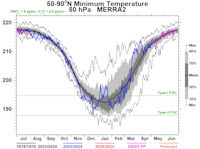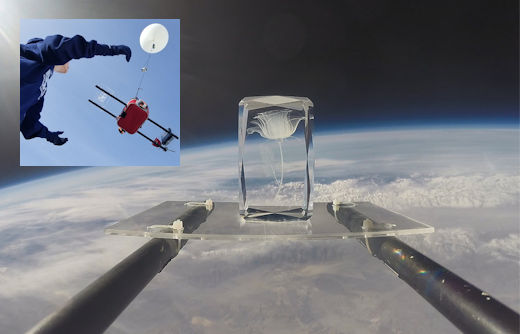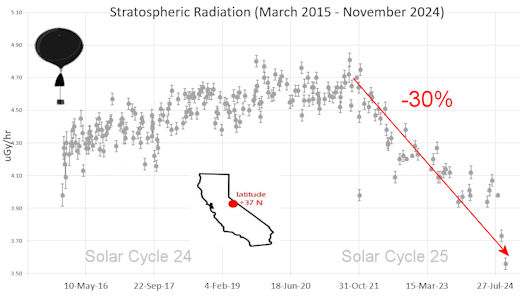 |
| |
Switch to: Europe, USA, New Zealand, Antarctica
Credit: NOAA/Ovation
 Planetary K-index
Planetary K-index
Now: Kp=
0.33 quiet
24-hr max: Kp= 2.67 quiet
explanation | more
data
Interplanetary Mag. Field
Btotal: 8.25 nT
Bz: -1.63 nT south
more data: ACE, DSCOVR
Updated: Today at 1136 UT
 Coronal Holes: 13 Sep 25
Coronal Holes: 13 Sep 25

Solar wind flowing from this large equatorial coronal hole could reach Earth on Sept. 14. Credit: NASA/SDO | more data

Polar Stratospheric Clouds
Colorful Type II polar stratospheric clouds (PSC) form when the temperature in the stratosphere drops to a staggeringly low -85C. NASA's MERRA-2 climate model predicts when the air up there is cold enough:

On Sep 13, 2025, the Arctic stratosphere is much too hot for polar stratospheric clouds. | more data.
Noctilucent Clouds
The northern season for noctilucent clouds is underway. First reports of the electric-blue clouds came from Russia on May 28, 2025. Since then, the clouds have spread to lower latitudes, reaching Paris, France, during a major outbreak on June 23, 2025. The seson is ending in an interesting way. Usually the clouds vanish in August, but they have persisted and sometimes been quite storng as August comes to an end.

Above: Aug. 21, 2025, Björköby, Finland
"These late season noctilucent clouds drifted in front of the crescent moon. It was quite beautiful," says photographer Sebastian Sainio.
See the complete NLC Photo Gallery

SPACE WEATHER
NOAA Forecasts |
|
Updated at: 2025 Sep 13 2200 UTC
FLARE |
0-24
hr |
24-48
hr |
CLASS M |
20
% |
20
% |
CLASS X |
01
% |
01
% |
 Geomagnetic Storms:
Geomagnetic Storms:
Probabilities for significant
disturbances in Earth's magnetic field are given for three activity levels: active, minor
storm, severe
storm
Updated at: 2025 Sep 13 2200 UTC
Mid-latitudes
|
0-24
hr |
24-48
hr |
ACTIVE |
35
% |
35
% |
MINOR |
30
% |
20
% |
SEVERE |
10
% |
05
% |
High latitudes
|
0-24
hr |
24-48
hr |
ACTIVE |
10
% |
10
% |
MINOR |
20
% |
30
% |
SEVERE |
65
% |
50
% |
|
|
|
 |
|
|
|
| |
|
|
|
| |
This is an AI Free Zone: Text created by Large Language Models is spreading across the Internet. It's well-written, but frequently inaccurate. If you find a mistake on Spaceweather.com, rest assured it was made by a real human being.
|
|
|
GEOMAGNETIC STORM WATCH (G1): Geomagnetic storms are possible on Sept. 14th when Earth's magnetic field could receive a one-two punch from the sun. Punch #1: A glancing blow from a faint CME. Punch #2: A stream of solar wind flowing from the Big Butterfly coronal hole. NOAA forecasters expect this to be a G1-class event with a chance of escalating to G2. Aurora alerts: SMS Text.
COMET SWAN25B UPDATE: After emerging from hiding behind the sun on Sept. 11th, Comet SWAN25B is rapidly brightening. Multiple southern hemisphere observers on Sept 13th say it is near magnitude +6--that is, about three times brighter than the day before. Gerald Rhemann and Michael Jäger send this picture from Farm Tivoli, Namibia:

"This is a 12/5/5/5 min (LRGB) exposure through a 12-inch Astrograph," says Rhemann.
The comet has a green atmosphere and a long blue ion tail collimated by the solar wind. These colors are signs of C2 (green) and CO+ (blue)--compounds commonly found in Solar System comets.
The comet's orbit is still being determined. Initial astrometry suggests it has already passed through perihelion (its closest approach to the sun). Next, it might make a close approach to Earth (0.25 AU) in October.
This weekend you can find SWAN25B in the constellation Virgo not far from Mars and Spica. It's still close to the sun, so be prepared to catch it near the horizon at sunset. Up-to-date coordinates may be found at the Minor Planet Center's Possible Comet Confirmation Page.
more images: from Filipp Romanov of Siding Spring Observatory, Australia; from Jost Jahn of Rio Hurtado, Chile; from Ray Pickard of Bathurst Observatory, Bathurst NSW, Australia
Realtime Space Weather Photo Gallery
Free: Spaceweather.com Newsletter
LASER-ETCHED CRYSTAL SPACE ROSE: This rose will last forever, and it comes from space. On Jan. 19th, the students of Earth to Sky Calculus launched the Crystal Space Rose to the stratosphere onboard a cosmic ray research balloon:

You can have it for $127.95. The bloom is laser-etched into a block of optical-quality borosilicate crystal with the words "I Love You" curving below the stem. It comes with an LED base that transforms the rose into a romantic night light.
The students are selling space roses to support their cosmic ray monitoring program. Each one comes with a greeting card showing the rose in flight and telling the story of its trip to the stratosphere and back again.
Far Out Gifts: Earth to Sky Store
All sales support hands-on STEM education
Realtime Aurora Photo Gallery
Free: Spaceweather.com Newsletter
Realtime Space Weather Photo Gallery
Free: Spaceweather.com Newsletter
Every night, a network
of NASA
all-sky cameras scans the skies above the United
States for meteoritic fireballs. Automated software
maintained by NASA's Meteoroid Environment Office
calculates their orbits, velocity, penetration depth
in Earth's atmosphere and many other characteristics.
Daily results are presented here on Spaceweather.com.
On Sep 13, 2025, the network reported 11 fireballs.
(8 sporadics, 3 September epsilon Perseids)

In this diagram of the inner solar system, all of the fireball orbits intersect at a single point--Earth. The orbits are color-coded by velocity, from slow (red) to fast (blue).
[Larger image] [movies]
Potentially Hazardous Asteroids ( PHAs)
are space rocks larger than approximately 100m that
can come closer to Earth than 0.05 AU. None of the
known PHAs is on a collision course with our planet,
although astronomers are finding new
ones all the time.
On September 13, 2025 there were 2349 potentially hazardous asteroids.
 |
Recent
& Upcoming Earth-asteroid encounters:
| Asteroid |
Date(UT) |
Miss Distance |
Velocity (km/s) |
Diameter (m) |
| 2019 JG1 |
2025-Sep-09 |
18.8 LD |
7.9 |
17 |
| 2025 RW1 |
2025-Sep-09 |
12.5 LD |
19.2 |
43 |
| 2025 QV9 |
2025-Sep-10 |
5.2 LD |
4.6 |
34 |
| 2025 QL7 |
2025-Sep-11 |
15.2 LD |
10.3 |
52 |
| 2025 QJ17 |
2025-Sep-11 |
17 LD |
5.8 |
27 |
| 2025 RR |
2025-Sep-11 |
11.3 LD |
22.4 |
45 |
| 2009 FF |
2025-Sep-11 |
6.8 LD |
12.9 |
155 |
| 2025 RU |
2025-Sep-11 |
8.4 LD |
18.6 |
29 |
| 2025 QO1 |
2025-Sep-11 |
8.7 LD |
13.6 |
80 |
| 2025 QL11 |
2025-Sep-12 |
6.1 LD |
5.4 |
15 |
| 2025 QX9 |
2025-Sep-12 |
17.7 LD |
3 |
16 |
| 2015 SA |
2025-Sep-13 |
10.3 LD |
9.1 |
31 |
| 2022 SS2 |
2025-Sep-13 |
2.4 LD |
7.2 |
13 |
| 2025 QV6 |
2025-Sep-14 |
18.1 LD |
6.9 |
40 |
| 2025 QR1 |
2025-Sep-14 |
19.7 LD |
8.7 |
155 |
| 2025 QK9 |
2025-Sep-16 |
4.2 LD |
8.4 |
51 |
| 2025 FA22 |
2025-Sep-18 |
2.2 LD |
10.8 |
166 |
| 2025 PJ1 |
2025-Sep-21 |
11.6 LD |
11.8 |
131 |
| 2022 SW12 |
2025-Sep-23 |
15 LD |
17.6 |
210 |
| 2018 QT1 |
2025-Sep-23 |
13.1 LD |
12.7 |
138 |
| 2021 RN16 |
2025-Sep-23 |
10.1 LD |
8.8 |
7 |
| 2019 SF6 |
2025-Sep-28 |
20 LD |
8.4 |
20 |
| 152664 |
2025-Sep-29 |
10.1 LD |
18.6 |
412 |
| 2025 QL23 |
2025-Oct-01 |
7.1 LD |
10 |
77 |
| 2020 GE1 |
2025-Oct-02 |
13.7 LD |
4.7 |
14 |
| 2022 TU1 |
2025-Oct-08 |
16.9 LD |
12.9 |
10 |
| 2020 QU5 |
2025-Oct-09 |
7.1 LD |
13.6 |
26 |
| 2022 AY5 |
2025-Oct-14 |
7.4 LD |
8.4 |
5 |
| 2022 UY3 |
2025-Oct-15 |
10.2 LD |
7.4 |
15 |
| 2022 UU15 |
2025-Oct-19 |
14.8 LD |
16.1 |
34 |
| 2023 UK3 |
2025-Oct-21 |
6.7 LD |
9 |
5 |
| 2024 GD2 |
2025-Oct-22 |
17.8 LD |
4.2 |
28 |
| 2022 HM1 |
2025-Oct-23 |
15.1 LD |
13.3 |
27 |
| 2012 TP231 |
2025-Oct-25 |
15.2 LD |
6.7 |
37 |
| 2020 FA5 |
2025-Oct-26 |
15.7 LD |
26.5 |
210 |
| 2009 HC |
2025-Oct-26 |
8.6 LD |
4.2 |
41 |
| 434196 |
2025-Oct-27 |
17.4 LD |
10.9 |
171 |
| 2023 VK6 |
2025-Nov-03 |
7.6 LD |
9.6 |
15 |
| 2021 VQ10 |
2025-Nov-08 |
9 LD |
15 |
13 |
| 2019 UH7 |
2025-Nov-08 |
13.3 LD |
5.8 |
11 |
| 2018 KC |
2025-Nov-09 |
16 LD |
9.3 |
11 |
| 2017 WG14 |
2025-Nov-09 |
16.7 LD |
11.7 |
45 |
| 2020 VK4 |
2025-Nov-10 |
16.4 LD |
3.8 |
9 |
| 2012 VC26 |
2025-Nov-11 |
13.3 LD |
6.4 |
6 |
Notes: LD means
"Lunar Distance." 1 LD = 384,401 km, the distance
between Earth and the Moon. 1 LD also equals 0.00256
AU.
| |
Cosmic Rays in the Atmosphere |
SPACE WEATHER BALLOON DATA: Almost once a week, Spaceweather.com and the students of Earth to Sky Calculus fly space weather balloons to the stratosphere over California. These balloons are equipped with sensors that detect secondary cosmic rays, a form of radiation from space that can penetrate all the way down to Earth's surface. Our monitoring program has been underway without interruption for 10 years, resulting in a unique dataset of in situ atmospheric measurements.
Latest results (Nov. 2024): Atmospheric radiation is sharply decreasing in 2024. Our latest measurements in November registered a 10-year low:

What's going on? Ironically, the radiation drop is caused by increasing solar activity. Solar Cycle 25 has roared to life faster than forecasters expected. The sun's strengthening and increasingly tangled magnetic field repels cosmic rays from deep space. In addition, solar coronal mass ejections (CMEs) sweep aside cosmic rays, causing sharp reductions called "Forbush Decreases." The two effects blend together to bring daily radiation levels down.
.Who cares? Cosmic rays are a surprisingly "down to Earth" form of space weather. They can alter the chemistry of the atmosphere, trigger lightning, and penetrate commercial airplanes. According to a study from the Harvard T.H. Chan school of public health, crews of aircraft have higher rates of cancer than the general population. The researchers listed cosmic rays, irregular sleep habits, and chemical contaminants as leading risk factors. A number of controversial studies (#1, #2, #3, #4) go even further, linking cosmic rays with cardiac arrhythmias and sudden cardiac death.
Technical notes: The radiation sensors onboard our helium balloons detect X-rays and gamma-rays in the energy range 10 keV to 20 MeV. These energies span the range of medical X-ray machines and airport security scanners.
Data points in the graph labeled "Stratospheric Radiation" correspond to the peak of the Regener-Pfotzer maximum, which lies about 67,000 feet above central California. When cosmic rays crash into Earth's atmosphere, they produce a spray of secondary particles that is most intense at the entrance to the stratosphere. Physicists Eric Regener and Georg Pfotzer discovered the maximum using balloons in the 1930s and it is what we are measuring today.
| |
The
official U.S. government space weather bureau |
| |
The
first place to look for information about sundogs,
pillars, rainbows and related phenomena. |
| |
Researchers
call it a "Hubble for the sun." SDO
is the most advanced solar observatory ever. |
| |
3D
views of the sun from NASA's Solar and Terrestrial
Relations Observatory |
| |
Realtime
and archival images of the Sun from SOHO. |
| |
information about sunspots based on the latest NOAA/USAF Active Region Summary |
| |
current counts of failed and deployed Starlink satellites from Jonathan's Space Page. See also, all satellite statistics. |
| |
Authoritative predictions of space junk and satellite re-entries |
| |
from
the NOAA Space Environment Center |
| |
fun to read, but should be taken with a grain of salt! Forecasts looking ahead more than a few days are often wrong. |
| |
from the NOAA Space Environment Center |
| |
the
underlying science of space weather |
 |
Got a chipped or cracked windshield that prevents you from seeing space weather events while driving? Get windshield replacement from SR Windows & Glass with free mobile auto glass service anywhere in the Phoenix area. |
 |
BestCSGOGambling is the best site for everything related to CSGO gambling on the web |
| |
These links help Spaceweather.com stay online. Thank you to our supporters! |
|
|
| |
|
|
|
|
 |
|
 |

 |
©2021 Spaceweather.com. All rights reserved. This site is penned daily by Dr. Tony Phillips. |
|